The next best thing to having an adventure? Reading about one.
Below is a list of books we recommend (or have written). Some will help you plan an adventure, some will take you on an adventure. All are highly relevant to our mission here at GetGoingNC.com of inspiring you to perspire.
To order any of these books, click on the title.
Our books
These books were written by GetGoingNC’s Joe Miller
 Adventure Carolinas (2013, UNC Press). Looking for an adventure. If you live in the Carolinas, you needn’t look far to find it, from whitewater paddling and rock climbing, to peaceful flatwater paddling and backcountry adventure, you’ll find it here. An overview of the activity followed by direction on how you can do it and where you can do it.
Adventure Carolinas (2013, UNC Press). Looking for an adventure. If you live in the Carolinas, you needn’t look far to find it, from whitewater paddling and rock climbing, to peaceful flatwater paddling and backcountry adventure, you’ll find it here. An overview of the activity followed by direction on how you can do it and where you can do it.
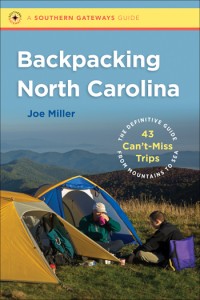 Backpacking North Carolina (2011, UNC Press). If you’ve done a backpack trip with Joe, chances are you’ll find that trip among the 43 covered in this book. A narrative of the experience, plus all the details you need to help you take the trip yourself. And they’re not all in the mountains: the Piedmont, and even the coast, are represented.
Backpacking North Carolina (2011, UNC Press). If you’ve done a backpack trip with Joe, chances are you’ll find that trip among the 43 covered in this book. A narrative of the experience, plus all the details you need to help you take the trip yourself. And they’re not all in the mountains: the Piedmont, and even the coast, are represented.
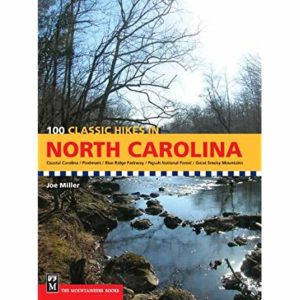 100 Classic Hikes in North Carolina (2007, Mountaineers). The best hikes in North Carolina? Not entirely. Rather, the criteria for this collection was that they be 100 hikes truly representative of the vast range of hiking options available in North Carolina, from the the coast to Clingman’s Dome.On
100 Classic Hikes in North Carolina (2007, Mountaineers). The best hikes in North Carolina? Not entirely. Rather, the criteria for this collection was that they be 100 hikes truly representative of the vast range of hiking options available in North Carolina, from the the coast to Clingman’s Dome.On
Books we love
Here are some of our favorite books, many of which we’ve written about over the years. If you’re interested, simply click on the image to purchase.
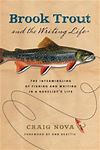 Brook Trout and the Writing Life, by Craig Nova (1999, Eno Publishers). Writing about fishing is rarely about fishing: it’s more a metaphor for exploring life in general. Thus, it’s a genre that can easily go wrong. Not with novelist Craig Nova, Distinguished Professor in the Humanities at UNC Greensboro. His ability to tie his passion for fishing with life helps the adventurous reader appreciate — recognize, actually — why the outdoors is such a vital part of our lives.
Brook Trout and the Writing Life, by Craig Nova (1999, Eno Publishers). Writing about fishing is rarely about fishing: it’s more a metaphor for exploring life in general. Thus, it’s a genre that can easily go wrong. Not with novelist Craig Nova, Distinguished Professor in the Humanities at UNC Greensboro. His ability to tie his passion for fishing with life helps the adventurous reader appreciate — recognize, actually — why the outdoors is such a vital part of our lives.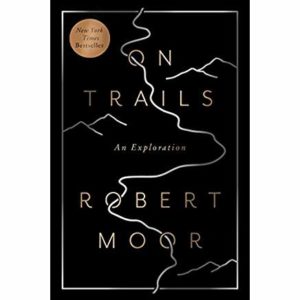 On Trails: An Exploration, by Robert Moor (2016, Simon & Schuster). Like many Appalachian Trail thru-hikers, Robert Moor couldn’t let go of the trail when he finished in 2009. So intrigued was he by this trail that he had just hike that felt compelled to learn more about trails: how they form, why they form, how long we (and our very distant predecessors) have been forming them. It all adds up to a compelling read that takes the reader down paths you had no idea were connected.
On Trails: An Exploration, by Robert Moor (2016, Simon & Schuster). Like many Appalachian Trail thru-hikers, Robert Moor couldn’t let go of the trail when he finished in 2009. So intrigued was he by this trail that he had just hike that felt compelled to learn more about trails: how they form, why they form, how long we (and our very distant predecessors) have been forming them. It all adds up to a compelling read that takes the reader down paths you had no idea were connected.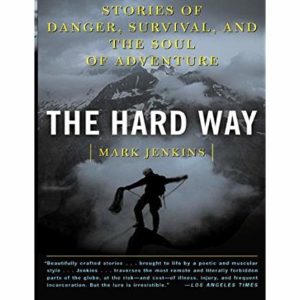 The Hard Way: Stories of Danger, Survival, and the Should of Adventure, by Mark Jenkins (2002, Simon & Schuster). Back in its prime, Outside magazine had the best adventure columnists going. One was Mark Jenkins, who, like the title of the book (also the title of his column) suggests, had a penchant of going about things the hard way. In part, that’s because of the places he visited, places, his book jacket notes, “where arrival is uncertain and an intact return is never guaranteed.” His literary gift is aided by the fact his accounts are first-hand.
The Hard Way: Stories of Danger, Survival, and the Should of Adventure, by Mark Jenkins (2002, Simon & Schuster). Back in its prime, Outside magazine had the best adventure columnists going. One was Mark Jenkins, who, like the title of the book (also the title of his column) suggests, had a penchant of going about things the hard way. In part, that’s because of the places he visited, places, his book jacket notes, “where arrival is uncertain and an intact return is never guaranteed.” His literary gift is aided by the fact his accounts are first-hand.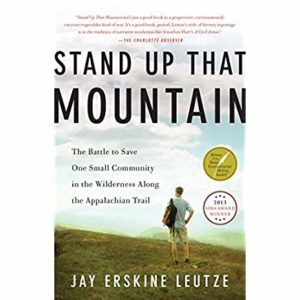 Stand Up That Mountain: The Battle to Save One Small Community in the Wilderness Along the Appalachian
Stand Up That Mountain: The Battle to Save One Small Community in the Wilderness Along the Appalachian Trail, by Jay Erskine Leutze (2012, Scribner). If you haven’t read this book already, elevate it to the top of your reading list, especially if you care one whit about the Southern Appalachians. The book documents (too harsh a word for this compellingly well-told story) about efforts to spare a coveted landscape (one that’s taken your breath away if you’ve hiked the AT at Hump Mountain) from the irreparable scar of a proposed quarry. Leutze joins in the fight, in a tale of people as much as about the land.
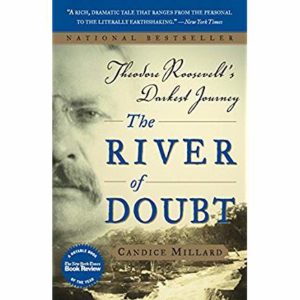 The River of Doubt: Theodore Roosevelt’s Darkest Journey, by Candice Millard (2005, Anchor Books). If you’ve ever wondered if all that talk about our 26th president being an avid outdoorsman might have been a bit … embellished, you certainly won’t after reading this account of his escape up the Amazon to an unnamed, unmapped tributary following his defeat in 1912.
The River of Doubt: Theodore Roosevelt’s Darkest Journey, by Candice Millard (2005, Anchor Books). If you’ve ever wondered if all that talk about our 26th president being an avid outdoorsman might have been a bit … embellished, you certainly won’t after reading this account of his escape up the Amazon to an unnamed, unmapped tributary following his defeat in 1912. One of the last true adventures.
 Wind: How the Flow of Air Has Shaped Life, Myth, and the Land, by Jan DeBlieu (1998, Houghton Mifflin). Looking for a good book the next time you head to the coast? “Wind” is most appropriate because, well, there’s a constant wind at the coast, and also because author Jan DeBlieu, as a resident of Manteo, knows of what she writes. All aspects of the wind are covered, from what makes it happen to its psychological impact on us.
Wind: How the Flow of Air Has Shaped Life, Myth, and the Land, by Jan DeBlieu (1998, Houghton Mifflin). Looking for a good book the next time you head to the coast? “Wind” is most appropriate because, well, there’s a constant wind at the coast, and also because author Jan DeBlieu, as a resident of Manteo, knows of what she writes. All aspects of the wind are covered, from what makes it happen to its psychological impact on us.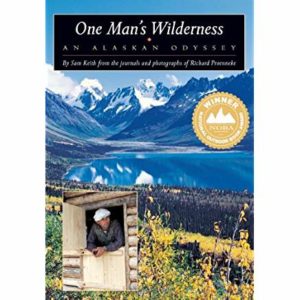 One Man’s Wilderness: An Alaskan Odyssey, by Sam Keith from the journals and photographs of Richard Proenneke (1973, Alaska Northwest Books). In 1967, when he was 50, Dick Proenneke decided he’d had enough of the civilized world and headed into the Twin Lakes region of the Alaska Range. There, he built a cabin on the edge of a lake and lived, isolated. Relying on Proenneke’s journal entries and his friendship with the Iowan, Sam Keith created this chronological account of Proenneke’s time at the cabin. Must reading for anyone who’s ever thought of doing the same.
One Man’s Wilderness: An Alaskan Odyssey, by Sam Keith from the journals and photographs of Richard Proenneke (1973, Alaska Northwest Books). In 1967, when he was 50, Dick Proenneke decided he’d had enough of the civilized world and headed into the Twin Lakes region of the Alaska Range. There, he built a cabin on the edge of a lake and lived, isolated. Relying on Proenneke’s journal entries and his friendship with the Iowan, Sam Keith created this chronological account of Proenneke’s time at the cabin. Must reading for anyone who’s ever thought of doing the same.
 Coming into the Country
Coming into the Country, by John McPhee (1976, Noonday). Coming into the Country is on just about everyone’s list of adventure read musts, and for good reason. McPhee tells the story of Alaska in three takes: The Encircled River (At the Northern Tree Line), What They Were Hunting For (In Urban Alaska), and Coming into the Country (In the Bush). Three remarkable tales that capture Alaska during the waning of its frontier mystique.
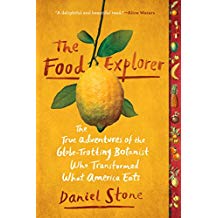 The Food Explorer, by Daniel Stone (2018, Dutton). Up until the late 1800s, food in this country was simply something you ate to survive, if it was tasty, well, that was a bonus. But that was starting to change, and young botanist David Fairchild, with a taste for both adventure and new foods, found himself at the right place at the right time. A chance meeting with Barbour Lathrop, a San Francisco millionaire with an insatiable wanderlust, set Fairchild on a worldwide search for foods that might grow in the U.S. Writer Daniel Stone tells the story of Fairchild’s exotic travels and the surprising impact those travels have had on what we grow and eat today (who knew kale isn’t a native food, but rather an import from cost of Austria-Hungary). A well-told tale.
The Food Explorer, by Daniel Stone (2018, Dutton). Up until the late 1800s, food in this country was simply something you ate to survive, if it was tasty, well, that was a bonus. But that was starting to change, and young botanist David Fairchild, with a taste for both adventure and new foods, found himself at the right place at the right time. A chance meeting with Barbour Lathrop, a San Francisco millionaire with an insatiable wanderlust, set Fairchild on a worldwide search for foods that might grow in the U.S. Writer Daniel Stone tells the story of Fairchild’s exotic travels and the surprising impact those travels have had on what we grow and eat today (who knew kale isn’t a native food, but rather an import from cost of Austria-Hungary). A well-told tale.-
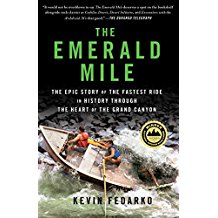 The Emerald Mile, by Kevin Fedarko (2014, Simon & Schuster). On the surface, this book is about an effort in 1983 by river guide Kenton Grua to capitalize on historic flooding in the Grand Canyon to set the record for running the 277-mile chasm. But it’s about so much more. Fedarko takes us back to when the first Spanish explorers stumbled across the canyon, to John Wesley Powell’s first descent, and to the Bureau of Reclamation’s efforts to tame the Colorado River — specifically with the Glen Canyon Dam. It’s all a fascinating set-up to the 1983 run by Grua and two mates in an attempt to break the Grand Canyon record (which Grua himself held).
The Emerald Mile, by Kevin Fedarko (2014, Simon & Schuster). On the surface, this book is about an effort in 1983 by river guide Kenton Grua to capitalize on historic flooding in the Grand Canyon to set the record for running the 277-mile chasm. But it’s about so much more. Fedarko takes us back to when the first Spanish explorers stumbled across the canyon, to John Wesley Powell’s first descent, and to the Bureau of Reclamation’s efforts to tame the Colorado River — specifically with the Glen Canyon Dam. It’s all a fascinating set-up to the 1983 run by Grua and two mates in an attempt to break the Grand Canyon record (which Grua himself held).  The Appalachian Trail Reader, edited by David Emblidge (1996, Oxford University Press). Emblidge tells the story of the fabled footpath through the people who hike it — and in their own words. Some essays in the book are by your favorite nature writers: Aldo Leopold, James McGregor Burns, Henry David Thoreau. But many are by rank-and-file hikers; in fact, some are simply trail journal entires, from the 1930s into the 1990s. Intended to be read in 5- and 10-minute installments, when you don’t have time to settle into your easy chair for the afternoon, but rather need a quick, satisfying fix.
The Appalachian Trail Reader, edited by David Emblidge (1996, Oxford University Press). Emblidge tells the story of the fabled footpath through the people who hike it — and in their own words. Some essays in the book are by your favorite nature writers: Aldo Leopold, James McGregor Burns, Henry David Thoreau. But many are by rank-and-file hikers; in fact, some are simply trail journal entires, from the 1930s into the 1990s. Intended to be read in 5- and 10-minute installments, when you don’t have time to settle into your easy chair for the afternoon, but rather need a quick, satisfying fix.
Reference
These references will help you find your way, and find out what it is that’s along the way.
 Fall Color and Woodland Harvests, by C. Ritchie Bell and Anne E. Lindsey (1990, Laurel Hill Press). If you’re a fall leaf peeper, you’ll want this reference on your shelf and in your pocket. The book includes an overview of the color phenomenon, including what to look for and where to look), plus detailed descriptions of 100 trees common to the region. Best of all, it comes with a condensed pocket guide to take into the woods.
Fall Color and Woodland Harvests, by C. Ritchie Bell and Anne E. Lindsey (1990, Laurel Hill Press). If you’re a fall leaf peeper, you’ll want this reference on your shelf and in your pocket. The book includes an overview of the color phenomenon, including what to look for and where to look), plus detailed descriptions of 100 trees common to the region. Best of all, it comes with a condensed pocket guide to take into the woods.
Fiction
Most good adventure and nature tales fall into the “you-can’t-make-this-up” category. Still, there are some made up tales in the genre that are worth a read.
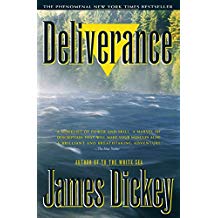 Deliverance, by James Dickey (1970, Houghton Mifflin). The story of “Deliverance” is best known through its release as a motion picture in 1972; John Boorman’s interpretation of James Dickey’s novel about four middle-age Atlanta businessmen who forgo an afternoon on the links for a paddle down the wild “Cahulawassee” River (the movie was shot on the Chattooga River). Their adventure doesn’t go as planned … . A cinematic masterpiece based on a book that was voted the 42nd best novel of the 20th Century by editors of the Modern Library.
Deliverance, by James Dickey (1970, Houghton Mifflin). The story of “Deliverance” is best known through its release as a motion picture in 1972; John Boorman’s interpretation of James Dickey’s novel about four middle-age Atlanta businessmen who forgo an afternoon on the links for a paddle down the wild “Cahulawassee” River (the movie was shot on the Chattooga River). Their adventure doesn’t go as planned … . A cinematic masterpiece based on a book that was voted the 42nd best novel of the 20th Century by editors of the Modern Library.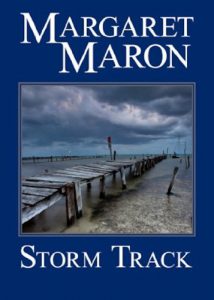 Storm Track, by Margaret Maron (2000). Got a hurricane barreling down on you? Curl up with this yarn that takes place in 1996 as Hurricane Fran is barreling through central North Carolina, home to fictional Colleton County and Maron’s Deborah Knott, a judge who anchors a series of Maron’s Deborah Knott mysteries. Though the action centers around a scandalizing murder, the impact of a major hurricane is a plot element that anyone who’s ever been through even a Category 1 storm will appreciate.
Storm Track, by Margaret Maron (2000). Got a hurricane barreling down on you? Curl up with this yarn that takes place in 1996 as Hurricane Fran is barreling through central North Carolina, home to fictional Colleton County and Maron’s Deborah Knott, a judge who anchors a series of Maron’s Deborah Knott mysteries. Though the action centers around a scandalizing murder, the impact of a major hurricane is a plot element that anyone who’s ever been through even a Category 1 storm will appreciate.
